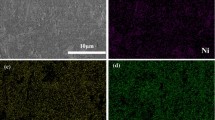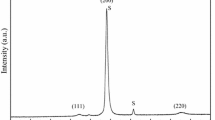Abstract
Tribochemically active Ti–C–S coatings are nanocomposite coatings containing a S-doped titanium carbide, from which S can be released in a tribological contact. This work studies tribochemical reactions between a Ti–C–S coating and various counter surface materials, and their effect on the tribological performance. Tribological tests were performed in a ball-on-disc set-up, using balls of five different materials as sliding partners for the coating: 100Cr6 steel, pure W, WC, 316-L steel and Al2O3. For W balls, a WS2 tribofilm was formed, leading to low friction (down to µ = 0.06). Furthermore, increasing normal load on the W balls was found to lead to a strong decrease in µ and earlier formation of the low-friction WS2 tribofilm. Similar WS2 and MoS2 tribofilms were, however, not formed from WC- and Mo-containing 316-L balls. The performance when using WC and Al2O3 balls was significantly worse than for the two steel balls. It is suggested that this is due to sulphide formation from Fe, analogous to formation of anti-seizure tribofilms from S-containing extreme pressure additives and steel surfaces. The tribochemical activity of Ti–C–S coatings, with the possibility of S release, is thus beneficial not only for pure W counter surfaces, but also for Fe-based sliding partners.







Similar content being viewed by others
References
Nossa, A., Cavaleiro, A.: The influence of the addition of C and N on the wear behaviour of W–S–C/N coatings. Surf. Coat. Technol. 142–144, 984–991 (2001)
Voevodin, A.A., O’Neill, J.P., Zabinski, J.S.: WC/DLC/WS2 nanocomposite coatings for aerospace tribology. Tribol. Lett. 6(2), 75–78 (1999)
Podgornik, B., Hren, D., Vižintin, J., Jacobson, S., Stavlid, N., Hogmark, S.: Combination of DLC coatings and EP additives for improved tribological behaviour of boundary lubricated surfaces. Wear 261(1), 32–40 (2006). doi:10.1016/j.wear.2005.09.007
De Barros, M.I., Bouchet, J., Raoult, I., Le Mogne, T., Martin, J.M., Kasrai, M., Yamada, Y.: Friction reduction by metal sulfides in boundary lubrication studied by XPS and XANES analyses. Wear 254(9), 863–870 (2003). doi:10.1016/S0043-1648(03)00237-0
Lara, J., Blunt, T., Kotvis, P., Riga, A., Tysoe, W.T.: Surface chemistry and extreme-pressure lubricant properties of dimethyl disulfide. J. Phys. Chem. B 102(10), 1703–1709 (1998)
Sawyer, W.G., Blanchet, T.A.: Lubrication of Mo, W, and their alloys with H2S gas admixtures to room temperature air. Wear 225–229, Part 1(0), 581–586 (1999). doi:10.1016/S0043-1648(99)00020-4
Sundberg, J., Nyberg, H., Särhammar, E., Kádas, K., Wang, L., Eriksson, O., Nyberg, T., Jacobson, S., Jansson, U.: Tribochemically active Ti–C–S nanocomposite coatings. Mater. Res. Lett. 1(3), 148–155 (2013). doi:10.1080/21663831.2013.802262
Sanchez-Lopez, J.C., Martinez-Martinez, D., Lopez-Cartes, C., Fernandez, A.: Tribological behaviour of titanium carbide/amorphous carbon nanocomposite coatings: from macro to the micro-scale. Surf. Coat. Technol. 202(16), 4011–4018 (2008)
Pei, Y.T., Galvan, D., De Hosson, J.T.M., Cavaleiro, A.: Nanostructured TiC/a-C coatings for low friction and wear resistant applications. Surf. Coat. Technol. 198(1–3), 44–50 (2005). doi:10.1016/j.surfcoat.2004.10.106
Lindquist, M., Wilhelmsson, O., Jansson, U., Wiklund, U.: Tribofilm formation and tribological properties of TiC and nanocomposite TiAlC coatings. Wear 266(3–4), 379–387 (2009). doi:10.1016/j.wear.2008.04.046
Oliver, W.C., Pharr, G.M.: An improved technique for determining hardness and elastic-modulus using load and displacement sensing indentation experiments. J. Mater. Res. 7(6), 1564–1583 (1992). doi:10.1557/jmr.1992.1564
Lewin, E., Wilhelmsson, O., Jansson, U.: Nanocomposite nc-TiC/a-C thin films for electrical contact applications. J. Appl. Phys. 100(5) (2006). doi:10.1063/1.2336302
Grosseau-Poussard, J.L., Moine, P., Brendle, M.: Shear strength measurements of parallel MoSx thin films. Thin Solid Films 307(1–2), 163–168 (1997). doi:10.1016/S0040-6090(97)00205-8
Chastain, J., King, R.C. (eds.): Handbook of X-ray Photoelectron Spectroscopy. Physical Electronics, Eden Prairie (1995)
Zabinski, J.S., McDevitt, N.T.: Raman spectra of inorganic compounds related to solid state tribochemical studies. In vol. WL-TR-96-4034. Wright-Patterson Air Force Base, Dayton, Ohio (1996)
de Faria, D.L.A., Venâncio Silva, S., de Oliveira, M.T.: Raman microspectroscopy of some iron oxides and oxyhydroxides. J. Raman Spectrosc. 28(11), 873–878 (1997). doi:10.1002/(sici)1097-4555(199711)28:11<873:aid-jrs177>3.0.co;2-b
Vogt, H., Chattopadhyay, T., Stolz, H.J.: Complete first-order Raman spectra of the pyrite structure compounds FeS2, MnS2 AND SiP2. J. Phys. Chem. Solids 44(9), 869–873 (1983). doi:10.1016/0022-3697(83)90124-5
Sundberg, J., Nyberg, H., Särhammar, E., Gustavsson, F., Kubart, T., Nyberg, T., Jacobson, S., Jansson, U.: Influence of Ti addition on the structure and properties of low-friction W–S–C coatings. Surf. Coat. Technol. 232, 340–348 (2013). doi:10.1016/j.surfcoat.2013.05.032
Voevodin, A.A., O’Neill, J.P., Zabinski, J.S.: Nanocomposite tribological coatings for aerospace applications. Surf. Coat. Technol. 116–119, 36–45 (1999)
Polcar, T., Evaristo, M., Cavaleiro, A.: Friction of self-lubricating W–S–C sputtered coatings sliding under increasing load. Plasma Process. Polym. 4(S1), S541–S546 (2007). doi:10.1002/ppap.200731402
Hai-dou, W., Da-ming, Z., Kun-lin, W., Jia-jun, L.: Comparison of the tribological properties of an ion sulfurized coating and a plasma sprayed FeS coating. Mater. Sci. Eng. A 357(1–2), 321–327 (2003). doi:10.1016/S0921-5093(03)00209-0
Hu, C., Zou, J., Qian, J., Jin, D., Sun, X.: Study on friction reduction and wear resistance process and composition of FeS solid lubrication duplex layer. Adv. Mater. Res. 502, 60–66 (2012)
Acknowledgments
The Swedish Foundation for Strategic Research is acknowledged for support.
Author information
Authors and Affiliations
Corresponding author
Rights and permissions
About this article
Cite this article
Nyberg, H., Sundberg, J., Särhammar, E. et al. Tribochemical Formation of Sulphide Tribofilms from a Ti–C–S Coating Sliding Against Different Counter Surfaces. Tribol Lett 56, 563–572 (2014). https://doi.org/10.1007/s11249-014-0437-6
Received:
Accepted:
Published:
Issue Date:
DOI: https://doi.org/10.1007/s11249-014-0437-6




